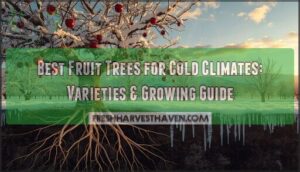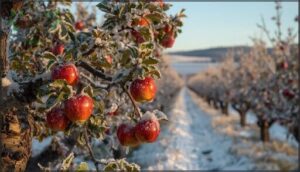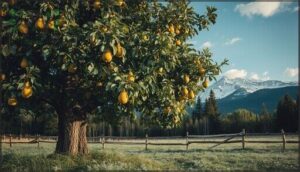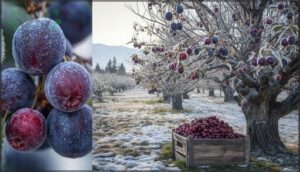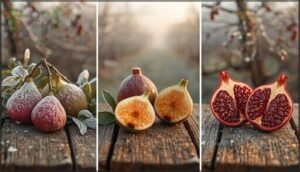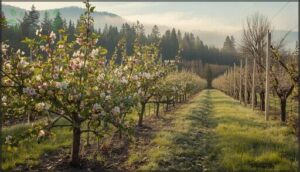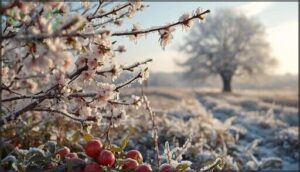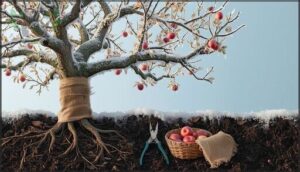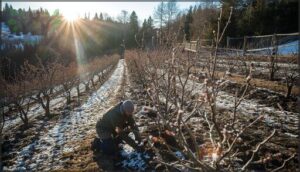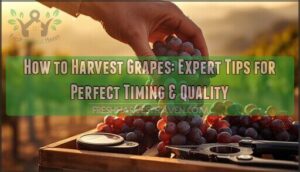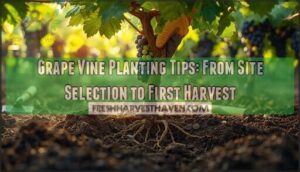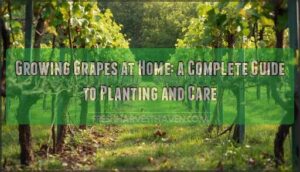This site is supported by our readers. We may earn a commission, at no cost to you, if you purchase through links.
Most gardeners assume fruit trees belong in warm climates, yet some of the hardiest varieties can survive winter temperatures that plunge to −40°F. These cold-adapted trees use biological tricks like deep dormancy, supercooling mechanisms, and antifreeze proteins to protect their cells when ice crystals form in surrounding tissues.
Understanding which fruit trees for cold climates can handle your specific hardiness zone—and how they’ve evolved to endure months of freezing conditions—transforms what seems impossible into a productive orchard.
The secret lies in matching proven cultivars like Haralson apples or Montmorency cherries to your region’s extreme minimums, then providing the soil drainage, sun exposure, and site selection that help these exceptional trees not just survive, but thrive and produce abundant harvests year after year.
Table Of Contents
- Key Takeaways
- What Makes a Fruit Tree Cold Hardy?
- Best Cold Hardy Fruit Trees to Grow
- Fast-Growing Fruit Trees for Cold Regions
- Self-Pollinating Cold Hardy Fruit Trees
- Essential Care for Cold Climate Fruit Trees
- Choosing and Planting Sites for Cold Hardy Trees
- Frequently Asked Questions (FAQs)
- Which fruit trees grow best in a cold climate?
- What temperature is too cold for fruit trees?
- What is the easiest fruit to grow in winter?
- What spacing distance works best between fruit trees?
- When should you plant cold hardy fruit trees?
- How do you winterize young fruit tree saplings?
- How much winter mulching do fruit trees need?
- Which soil amendments work best for cold regions?
- What fertilizer schedule works for cold climate orchards?
- How do chill hours affect fruit production?
- Conclusion
Key Takeaways
- Cold-hardy fruit trees survive extreme winters down to −40°F through biological adaptations like deep dormancy, supercooling mechanisms, and antifreeze proteins that protect cells when surrounding tissues freeze.
- Selecting the right cultivar for your USDA hardiness zone is critical—proven varieties like Haralson apples (Zone 3–4), Montmorency cherries (Zone 4), and Russian-bred Nova pears (Zone 2–3) reliably produce fruit after brutal winters.
- Self-pollinating varieties like Golden Delicious apples and Montmorency cherries eliminate the need for companion trees, making them ideal for small spaces while still delivering consistent harvests in cold climates.
- Site selection matters as much as variety choice—plant on gentle slopes (4–8% grade) with excellent air drainage to prevent frost pockets, provide 8 hours of full sun daily, and ensure well-draining soil with 3–4 inches of mulch for root protection.
What Makes a Fruit Tree Cold Hardy?
Not every fruit tree can handle months of freezing temperatures and late spring frosts. Cold hardy varieties have developed specific traits that let them survive—and even thrive—in harsh winter conditions.
Understanding what makes a tree cold hardy will help you choose varieties that won’t just survive in your garden, but actually produce fruit year after year.
Key Adaptations for Surviving Freezing Temperatures
Cold hardy fruit trees survive winter through striking biological tricks. During cold acclimation, they enter deep dormancy and can withstand temperatures between −25 and −35°C in buds. Their cells use supercooling mechanisms to keep water liquid below freezing, while cellular dehydration and antifreeze proteins protect membranes. These winter hardy adaptations let freeze-tolerant plants endure harsh conditions that would kill tender varieties.
Cold hardy fruit trees survive extreme winter through deep dormancy, supercooling cells, and antifreeze proteins that protect against temperatures reaching −35°C
The process of chilling hours is vital for breaking dormancy stages in fruit trees.
USDA Hardiness Zones Explained
To choose the right cold hardy fruit trees, you’ll need to understand the USDA hardiness zone system. These zones map regional variations by dividing North America into thirteen climate classification bands, each representing a 10°F temperature range in average annual minimum winter temperatures.
Zone 3 sits at −40°F to −30°F, while Zone 7 spans 0°F to 10°F—your zone determines which winter hardy fruit trees will actually survive. Gardeners can find their specific hardiness zone maps to decide on the best fruit trees for their area.
Cold Hardiness Vs. Cold Tenderness
Understanding the contrast between hardiness and tenderness helps you pick winners for your orchard. Cold hardiness lets tissues survive subfreezing temps—some apple buds tolerate down to −23°C during full dormancy—while cold tenderness means injury strikes at just a few degrees below freezing.
Chill hours, deacclimation during warm spells, and winter injury risk all shape your fruit tree care strategy in cold climates.
Best Cold Hardy Fruit Trees to Grow
Not every fruit tree can handle long winters and late frosts, but the right varieties will reward you with reliable harvests year after year. You’ll want to focus on proven performers that can withstand freezing temperatures and still produce quality fruit.
Here are the best cold hardy options to examine for your northern garden.
Apple Tree Varieties for Harsh Winters
If you’re planting in zones 2–4, you’ll want cultivars like Haralson, which tolerates winter lows around -40°F, or Honeycrisp, developed through over a century of Minnesota apple breeding for extreme cold hardiness.
These apple tree varieties demonstrate exceptional winter resilience and climate adaptation, beginning fruit production within two to three years while maintaining excellent storage quality even after harsh winters—essential traits for successful cold climate orchards.
Pear Trees for Cold Climates
Russian-bred Nova pear tree cultivars bring extreme hardiness to zones 2–3, surviving winter lows below -50°F when planted with proper tree sheltering against wind. Cold hardy roots anchor these selections through brutal conditions, enabling reliable fruit ripening by late August in short-summer climates.
Here’s what you need to know about pear cultivation in cold regions:
- ‘Golden Spice’ and ‘Krazulya’ thrive in Zone 2b near heat-reflecting structures
- Most European pears perform best in zones 5–8, requiring milder winters
- Cold-climate cultivars usually fruit within 2–3 years after tree planting
- Winter pruning should remain light to avoid yield depression the following season
- ‘Vermont Beauty’ shows outstanding fire blight resistance alongside zone 4 hardiness
Reliable Plum and Cherry Options
Sour cherries, such as the Montmorency variety, are well-suited for cold climate orchards in zones as frigid as zone 4, tolerating winter lows near -30°F without bud damage. European plum trees, including the ‘Mount Royal’ and hybrid ‘Pembina’ varieties, are also notable for their ability to thrive in harsh conditions, averaging over 15 pounds of fruit per season.
| Variety Type | Hardiness & Traits |
|---|---|
| Sour Cherry | Zone 4; reliable harvest timing, frost protection natural |
| European Plum | Zone 3–5; cold hardy fruit trees, delayed bloom reduces frost risk |
| Bush Cherry | Zone 3–7; compact form, up to 25 lb yield per shrub |
European plums have a distinct advantage over Japanese types due to their later blooming period, which helps them avoid late spring frosts that can devastate early flowers.
Unique Exotics: Paw Paw, Fig, Pomegranate
Pawpaw trees push the boundaries of cold-climate exotic fruit, thriving in zones 5–8 and tolerating winter lows near -30°F when dormant.
Chicago Hardy fig survives zone 5 with mulch protection, regrowing from roots hardy to -20°F. Russian-type pomegranates endure temperatures around 0°F, expanding your options for unique harvests.
These cold hardy fruit trees require warm microclimates and patience—pawpaws may need 10 years to reach full production.
Fast-Growing Fruit Trees for Cold Regions
If you’re keen to taste your first homegrown harvest, some cold hardy fruit trees start producing surprisingly fast. You won’t need to wait a decade—certain varieties can bear fruit in just two to three years after planting.
Let’s look at the fastest options for cold regions and how you can speed up their growth even more.
Rapidly Maturing Apple and Plum Trees
If you’re keen to harvest your own fruit within just a few seasons, precocious cultivars bred specifically for cold climate orchards deliver rapid maturation without sacrificing winter hardiness. Fruit tree breeding programs have developed apple and plum varieties that bear remarkably early, transforming cold climate gardening into a faster, more rewarding experience.
- Dwarf apple trees on rootstocks like M.9 or G.41 often fruit in 2–3 years, compared to 10–12 years for standard trees
- Cold-hardy apples such as ‘Honeycrisp’, ‘Empire’, and ‘Parkland’ thrive in zones 3–4 while fruiting quickly
- Japanese plum varieties like ‘Methley’ and ‘Santa Rosa’ begin bearing within 3–6 years after planting
- ‘Golden’ plum tolerates zones 5–10, producing sweet yellow fruit on compact, manageable trees
- Proper fruit tree selection and sunlight exposure accelerate fruiting timelines in growing fruit trees in cold climates
Quick-Yielding Blueberry Bushes
Blueberry plants offer outstanding value for cold-climate gardeners seeking rapid fruit production. Northern highbush cultivars like ‘Northland’ and ‘Patriot’ thrive in zones 3-4, yielding fruit by the second or third year after transplanting. These self-pollinating blueberry shrubs produce 5–20 pounds per mature plant. Cold Hardy Polaris Arctic Blueberry Shrub tolerates -35°F while delivering 3–7 pounds annually.
Here’s what to expect:
| Cultivar | Cold Tolerance | Mature Yield (lbs/year) |
|---|---|---|
| ‘Northland’ | Zone 3 | 15–20 |
| ‘Patriot’ | Zone 3 | 5–10 |
| ‘Northblue’ | -35°F | 3–7 |
| Southern Highbush | Zone 5+ | 8+ |
Proper blueberry bush care—acidic soil, consistent moisture, and annual pruning—advances harvest timing by several days. By year six, well-managed plants can yield roughly 2 gallons per season, making berry variety selection critical for maximizing cold climate yields and optimizing fruit production tips in your orchard.
Tips for Accelerating Growth in Cold Climates
You can shorten the wait for harvest by focusing on three proven strategies: optimizing soil preparation with organic amendments to boost available water by 2–3 mm per 100 mm depth, applying balanced nitrogen early in spring to support vigorous shoot extension, and using mulches or row covers for frost protection and microclimate management.
These tree care practices accelerate growth in coldhardy fruit tree varieties while ensuring sturdy cold climate performance.
Self-Pollinating Cold Hardy Fruit Trees
If you’re working with limited space or don’t want to manage multiple trees for cross-pollination, self-pollinating varieties are your best bet.
These cold hardy fruit trees can set fruit on their own, which means you’ll get a reliable harvest without planting a companion tree nearby.
Let’s look at some of the most dependable self-fertile options for cold climates.
Best Self-Fertile Apple and Pear Cultivars
When fruit tree genetics align with self-fertility factors, you can plant a single tree and still harvest baskets of fruit. In cold climates, winter chill requirements become critical—your tree needs enough dormant hours to bloom reliably.
Here are proven self-pollinating apple and pear varieties that thrive where temperatures plummet:
- Golden Delicious apple – Self-fertile and cold-hardy, bearing fruit 4–6 years after planting
- Anna apple – Hardy to Zone 5 with low chill needs; self-fruitful in trials
- Honeysweet pear – Self-fertile, surviving winters to −35 °F with sweet September harvests
- Southworth pear – Zone 3 hardy; tremendously reliable annual producer without cross-pollination
Self-Pollinating Cherry and Fig Trees
Cherry trees and fig trees bring versatility to cold hardy fruit trees when you choose self-pollinating varieties. Montmorency tart cherry thrives in zones 4–7 without a partner, while North Star reaches just 8–10 feet and tolerates zone 4 winters beautifully.
For figs in cold climates, ‘Chicago Hardy’ survives zone 5 by resprouting after dieback, and ‘Celeste’ fruit ripens reliably with winter frost protection and careful fig tree pruning.
Benefits for Small or Urban Gardens
Self-pollinating dwarf fruit trees transform small space gardening and urban fruit production by eliminating the need for multiple pollinizers. You can grow a single columnar apple or dwarf cherry in container growing setups on balconies, producing 1–4 bushels annually while occupying less than one square foot.
City orchard management becomes practical when compact, self-fertile cultivars deliver reliable harvests without ladder work in cold hardy zones.
Essential Care for Cold Climate Fruit Trees
Growing fruit trees in cold climates isn’t just about choosing hardy varieties—it’s about giving them the right care once they’re in the ground. Your trees will need proper soil conditions, regular maintenance, and protection from winter’s toughest punches to produce reliably year after year.
Let’s look at the essential care practices that’ll help your cold-hardy fruit trees not just survive, but thrive through harsh winters and come back strong each spring.
Soil, Sunlight, and Water Requirements
Well-draining soil with a pH between 6.0 and 6.5 sets the foundation for healthy root growth in cold regions. A 2- to 4-inch mulch layer conserves moisture without waterlogging roots, while organic matter improves structure and fosters long-term vitality.
Your trees need about 8 hours of full sun daily—apples, pears, and cherries won’t compromise on this. Plan for roughly 1 inch of water per week, adjusting for your soil types.
Pruning and Fertilization Tips
Time your pruning for late winter—January through March works best for most cold hardy fruit trees, when they’re dormant but before budbreak. Moderate cuts maintain strong scaffolds without triggering excessive vigor that risks winter injury.
Apply 30 to 45 kg nitrogen per hectare in early spring, adjusted to your soil type and tree species, using annual shoot growth as your guide for adjusting rates.
Protecting Trees From Frost and Winter Damage
Beyond the basics, active Frost Protection makes all the difference for Cold Hardy Fruit Trees facing harsh winters. Overhead sprinklers consistently outperform heating systems in preventing Winter Injury, while horticultural fleece layered over blossoms provides 1–5 °C of Damage Prevention during critical spring Frost events.
Build Cold Resilience through trunk wraps and soil moisture management—simple Tree Insulation that dramatically improves Fruit Tree Hardiness and Winter Care outcomes.
Choosing and Planting Sites for Cold Hardy Trees
Where you plant your cold hardy fruit trees matters just as much as which varieties you choose. The right site can mean the difference between a thriving orchard and years of disappointing harvests or winter losses.
Let’s look at the key factors that will set your trees up for long-term success in cold climates.
Selecting The Right Location and Elevation
Choosing your site is where science meets common sense. Elevation effects can shift temperatures enough to preserve cold-hardy fruit trees through late frosts—commercial orchards often sit between 300 and 900 meters, where cooler air fosters reliable fruit set.
Slope selection matters too: gentle grades of 4 to 8 percent promote air drainage, reducing frost risk while maximizing sunlight exposure for growing fruit trees in cold climates.
Importance of Air Drainage and Microclimates
Your orchard’s invisible enemy is cold air pooling—and air drainage systems can stop it. Even a modest 4–8% slope lets dense, frosty air slide downhill instead of settling around your cold hardy fruit trees.
Microclimate effects matter too: orchard floors with cover crops run 4°F colder than bare soil during frost events, while south-facing slopes warm faster and hold heat longer, cutting frost risk factors markedly.
Where to Buy Cold Hardy Fruit Trees
You’ll find cold hardy fruit trees through several channels—each with distinct advantages. Online nurseries dominate the market at nearly $7 billion in 2024, offering zone-filtered catalogs and prices from $23 to $90 per tree. Local garden centers provide regionally tested stock, while specialty stores stock extreme-climate cultivars for Zones 1–4.
- Online Nurseries: Zone-specific filtering, free shipping on bulk orders, widest cold climate suppliers selection
- Local Garden Centers: Regionally adapted fruit tree varieties, immediate availability, expert advice on orchard management in cold climates
- Specialty Stores: Extreme-hardy selections (−30°F tolerant), organic certification, grafted cold hardy fruit trees for challenging zones
- Extension Partnerships: Verified fruit tree retail sources, tree care guidance, proven gardening in cold climates cultivars
Frequently Asked Questions (FAQs)
Which fruit trees grow best in a cold climate?
Think apple and pear cultivars rated for USDA Zones 3–4, tolerating winter lows to –30°F or colder.
Cold hardy fruit trees like these thrive where frost resistance and site selection matter most.
What temperature is too cold for fruit trees?
When winter temperatures drop below −29 to −34 °C (−20 to −30 °F), most apple and pear trees risk serious winter injury.
Stone fruits like peaches face damage around −26 °C (−15 °F), limiting cold climate success.
What is the easiest fruit to grow in winter?
Many seasoned growers discover that apples consistently outperform fancier fruits when temperatures plummet.
Hardy cultivars like ‘Liberty’ tolerate brutal zone 4 winters, resist common diseases, and reliably produce fruit—making them the easiest cold-hardy fruit tree choice.
What spacing distance works best between fruit trees?
Orchard layout depends on tree size—dwarf fruit trees need 6–8 feet between them, semi-dwarf varieties require 15 feet, and full-sized trees demand 25 feet for maximum fruit yield and row management.
When should you plant cold hardy fruit trees?
Timing your planting means balancing soil workability with tree dormancy. In zones 3–5, plant bare-root varieties in early spring after thaw; milder zones allow fall windows when roots establish before freezing temperatures arrive.
How do you winterize young fruit tree saplings?
You’ll need trunk protection from sunscald, 3 to 4 inches of mulch for root insulation, rodent guards buried 2 inches deep, consistent watering before dormancy, and breathable covers during hard freezes.
How much winter mulching do fruit trees need?
You’ll want to pile on 3 to 4 inches of shredded wood mulch over the root zone—enough winter insulation to stabilize soil temperature and shield roots from freeze-thaw cycles without suffocating them.
Which soil amendments work best for cold regions?
Well-draining soil rich in organic matter is your foundation. Add compost to boost microbial activity, biochar for water retention, and adjust soil pH with lime or sulfur.
Compost teas deliver beneficial microbes cold hardy fruit trees need.
What fertilizer schedule works for cold climate orchards?
Getting your orchard nutrition right means matching fertilizer rates to growth stages. Apply nitrogen from budbreak through petal fall, split calcium sprays midseason, and rely on soil testing to adjust timing each year.
How do chill hours affect fruit production?
Chill hours—measured hours between 32 and 45°F—trigger dormancy release in deciduous fruit trees. Insufficient chilling hours delay budbreak, reduce fruit set, and lower yields.
Low-chill cultivars needing under 500 hours suit warmer winters best.
Conclusion
The gardeners who succeed with fruit trees for cold climates share one unexpected trait: they stop fighting winter and start working with it. By choosing cultivars bred for your hardiness zone, planting in well-drained sites with strong air circulation, and protecting young bark from frost cracks, you’re not just growing trees—you’re partnering with varieties that have evolved to thrive where others fail.
Your orchard begins with matching biology to climate, not wishful thinking.
- https://www.gardeningknowhow.com/garden-how-to/gardening-by-zone/zone-3/cold-hardy-apples-in-zone-3.htm
- https://www.foodforestnursery.com/shop/fruit-trees/by-climate-zone/fruit-trees-for-zone-4/
- https://psgsc.webhosting.cals.wisc.edu/wp-content/uploads/sites/205/2012/09/Luby.pdf
- https://agroinsurance.com/uploads/files/61308a02c153e.pdf
- http://www.royaloak.farm/critical-spring-temperatures-for-frost-damage

